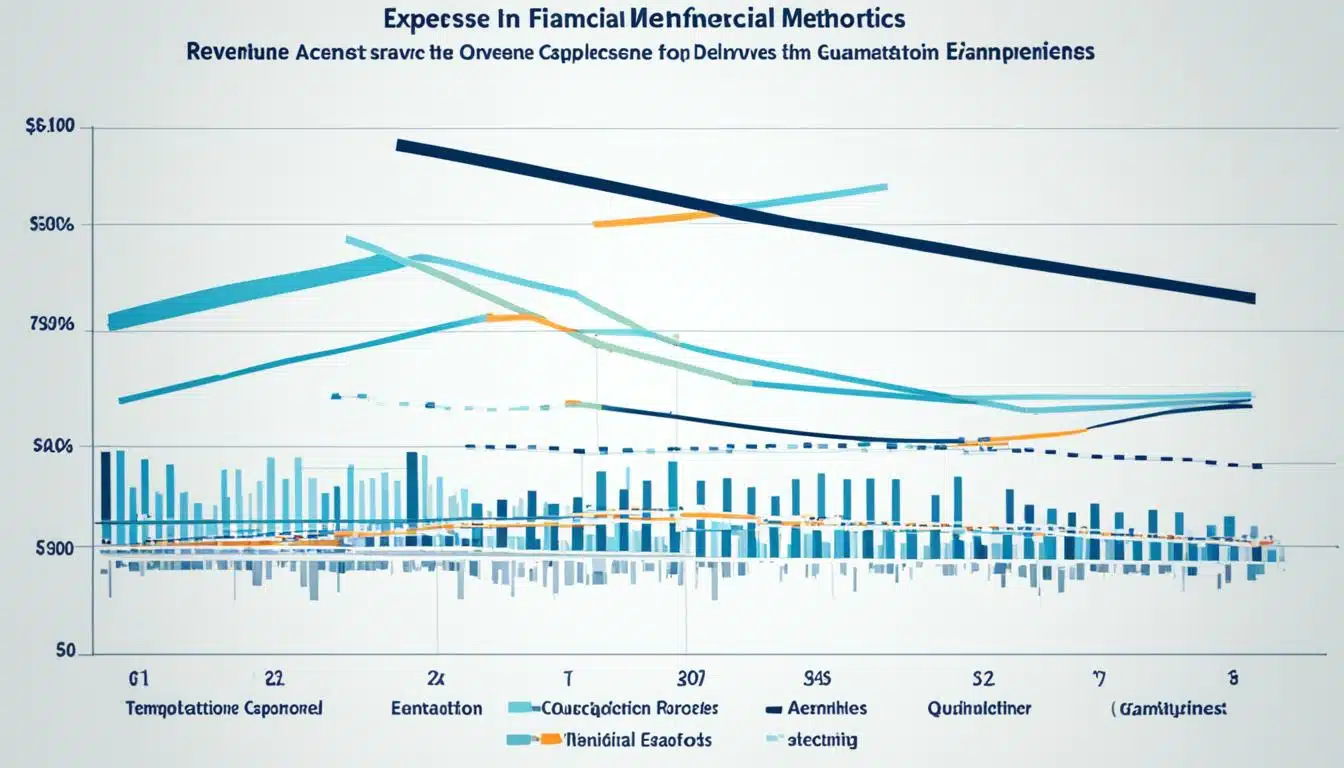In the rapidly evolving world of finance, the importance of quantitative analysis (QA) has become increasingly evident. Quantitative finance, which encompasses the application of mathematical and statistical techniques to analyse financial data, has emerged as a critical discipline for making informed investment and trading decisions. By leveraging sophisticated quantitative models, financial analysts and professionals can uncover hidden patterns, identify potential risks, and unlock valuable insights that drive more strategic and data-driven financial management.
Quantitative analysis in finance encompasses a wide range of techniques, from regression analysis and linear programming to data mining and Monte Carlo simulations. These tools enable finance professionals to tackle complex challenges, such as portfolio optimisation, derivatives pricing, risk management, and financial forecasting. By combining strong quantitative skills with a deep understanding of financial theory and industry dynamics, finance professionals can navigate the ever-changing financial landscape with greater precision and confidence.
Key Takeaways
- Quantitative analysis in finance involves the use of mathematical and statistical techniques to analyse financial data and make more informed investment decisions.
- Quantitative finance professionals leverage a range of tools, including regression analysis, linear programming, and data mining, to uncover insights and optimise financial strategies.
- Quantitative methods are widely applied in various business functions, such as project management, production planning, marketing, and financial analysis, to support data-driven decision-making.
- Forecasting and scenario analysis are crucial quantitative techniques that help finance professionals navigate uncertainty and manage risks effectively.
- The growing demand for quantitative finance experts has led to the emergence of specialised career paths, such as quantitative analysts, financial engineers, and data scientists in finance.
Introduction to Finance Quantitative Analysis
Quantitative analysis (QA) is a set of techniques that use mathematical and statistical modelling, measurement, and research to understand the behaviour of financial markets and make more informed investment decisions and trading strategies. QA starts with data collection, where analysts gather a vast amount of financial data that might affect the market, including stock prices, company earnings, and economic indicators. They then use various mathematical models and statistical techniques to analyse this data, looking for trends, patterns, and potential investment opportunities in quantitative asset management and trading.
Definition and Purpose of Quantitative Analysis
Quantitative analysis in finance refers to the use of quantitative methods, such as statistical and mathematical models, to analyze financial data and make more informed decisions. The purpose of QA is to provide a data-driven, objective approach to understanding market behaviour, risk management, and forecasting potential outcomes, ultimately supporting more effective investment decisions and trading strategies.
Also Read : Finding The Right Fit For Your Needs By Understanding Loan Options
Importance of Data-Driven Decision Making
In the modern financial landscape, data-driven decision making has become increasingly crucial. Quantitative analysis enables financial professionals to move beyond relying on intuition or subjective judgements and instead base their decisions on rigorous analysis of financial data. This approach can lead to more informed, data-driven investment decisions, trading strategies, and risk management practices, ultimately improving the performance and resilience of financial institutions and individual investors.
Key Quantitative Analysis Techniques
Quantitative finance employs a diverse array of sophisticated techniques to analyze extensive financial data and generate actionable insights for portfolio management and investment strategies. Key methods in this field include regression analysis, which uses mathematical and statistical approaches to identify relationships between variables; linear programming, which optimises resource allocation; and data mining, which applies data science to uncover patterns and trends within large datasets. Integrating these quantitative research techniques with fundamental analysis and analytics, professionals can enhance portfolio performance. Additionally, the use of artificial intelligence in quantitative finance is expanding, providing innovative solutions not only in finance but also in other industries. By leveraging mathematical and statistical methods, quantitative finance continues to evolve, offering powerful tools for effective portfolio management and decision-making.
Also Read : From Shave To Shine: Simplifying Your Daily Men’s Skincare Routine
Regression Analysis
Regression analysis is a statistical technique used to model the relationship between a dependent variable (such as stock price or portfolio return) and one or more independent variables (such as economic indicators or financial ratios). By identifying the strength and direction of these relationships, finance professionals can develop predictive models to forecast future performance, assess risk, and make more informed investment strategies.
Linear Programming
Linear programming is a mathematical optimization technique used to allocate limited resources, such as capital or personnel, to achieve the best possible outcome. In finance, linear programming can be used to optimize portfolio optimisation, resource allocation, and risk management strategies, helping organizations make the most efficient use of their financial resources.
Data Mining
Data mining is the process of analyzing large datasets to identify patterns, trends, and relationships that can be used to make more informed decisions. In finance, data mining techniques such as cluster analysis, classification, and association rule mining can be used to uncover hidden insights, predictive models, and data-driven insights that can inform financial decision making, risk modeling, and derivatives pricing.
Also Read : How To Get Financial Well Being To Raise Your Credit Score?
These three quantitative analysis techniques, along with other statistical and mathematical methods, form the foundation of modern finance, enabling organizations to make more informed, data-driven decisions that can optimize financial modelling, investment strategies, and risk management approaches.
Finance Quantitative Methods in Business
Quantitative analysis plays a vital role in various business functions, enabling organizations to make more informed, data-driven decisions. Some of the key applications of quantitative methods in business include:
Project Management
Quantitative techniques, such as linear programming and optimization algorithms, can help project managers allocate resources more efficiently, forecast project timelines, and mitigate risks. These methods are instrumental in areas like production planning, cost reduction, and profit maximization.
Also Read : Your Path To Ageless Beauty Starts Here: Introducing Life Cell Skincare
Production Planning
Quantitative analysis plays a crucial role in production planning and inventory management by utilizing techniques such as forecasting, linear programming, and data mining. These methods enable organizations to optimize their supply chains, predict customer demand, and effectively manage inventory levels.
Marketing Strategies
Quantitative techniques, such as regression analysis and data mining, can provide valuable insights for developing effective marketing strategies. These methods help businesses analyze customer behavior, segment markets, and optimize marketing campaigns to drive profit maximization.
Financial Analysis and Investments
Quantitative methods are widely used in financial analysis and investment decisions. Techniques like financial modeling, statistical analysis, and portfolio optimization support activities such as valuation, risk management, and financial reporting.
Purchase and Inventory Management
Quantitative methods, including forecasting, data mining, and optimization, can streamline purchase and inventory management processes. These techniques help businesses optimize resource allocation, improve inventory control, and enhance cost reduction efforts.
Also Read : Navigating the world of skincare treatments from facials to peels
| Business Function | Quantitative Methods Applied | Key Benefits |
|---|---|---|
| Project Management | Linear programming, optimization algorithms | Efficient resource allocation, accurate forecasting, risk mitigation |
| Production Planning | Forecasting, linear programming, data mining | Optimized supply chain, anticipation of customer demand, inventory control |
| Marketing Strategies | Regression analysis, data mining | Insights for effective marketing campaigns, customer segmentation, profit maximization |
| Financial Analysis and Investments | Financial modeling, statistical analysis, portfolio optimization | Accurate valuation, risk management, informed investment decisions, financial reporting |
| Purchase and Inventory Management | Forecasting, data mining, optimization | Optimized resource allocation, improved inventory control, cost reduction |
Financial Forecasting
Financial forecasting leverages a range of quantitative techniques, including time series analysis, regression analysis, and statistical modeling, to predict future financial performance. Analysts utilize these methods to forecast demand, expenses, cash flow, and even startup costs, equipping decision-makers with the insights needed to allocate resources, manage budgets, and make strategic investments. By incorporating predictive models and robust data analysis, organizations can enhance their financial planning and drive more data-driven decision-making.
Scenario Analysis for Risk Management
Scenario analysis is a powerful tool for identifying and mitigating risks. Quantitative techniques, such as Monte Carlo simulations, allow organizations to explore multiple potential outcomes and their associated probabilities. This approach enables risk managers to anticipate a range of economic, market, and operational challenges, from fluctuations in market conditions to unexpected crises. By simulating different scenarios, businesses can develop contingency plans, implement risk mitigation strategies, and make informed investment decisions that account for various uncertainties.
| Technique | Application | Key Benefits |
|---|---|---|
| Time Series Analysis | Demand Forecasting, Cash Flow Projections | Identify trends, patterns, and seasonality in financial data to improve predictive accuracy |
| Regression Analysis | Expense Forecasting, Startup Cost Estimation | Determine the relationship between variables and use it to forecast future financial performance |
| Monte Carlo Simulation | Scenario Analysis, Risk Assessment | Simulate multiple potential outcomes and their probabilities to inform strategic planning and risk mitigation |
Valuation Models and Monte Carlo Simulations
Quantitative analysis in financial economics also encompasses techniques for valuing companies, assets, and investments, as well as simulating multiple potential outcomes through Monte Carlo simulations. These advanced methods play a crucial role in investment decisions, mergers and acquisitions, and overall financial modeling.
Valuation Models for Company and Asset Worth
Valuation models, such as the discounted cash flow (DCF) approach, are used to estimate the intrinsic value of a company or asset. These models take into account factors like market volatility, risk assessment, and uncertainty to arrive at a fair assessment of the entity’s worth. Accurate company valuation and asset valuation are essential for making informed investment decisions and navigating complex financial engineering scenarios.
Monte Carlo Simulations for Multiple Outcomes
Monte Carlo simulations are a powerful tool for scenario planning and probabilistic analysis. By running multiple randomized scenarios, these simulations can help finance professionals understand the range of possible outcomes, assess risk, and make more informed decisions regarding portfolio management, derivatives pricing, and option pricing. The insights gained from these stochastic processes and computational finance techniques are invaluable for navigating market volatility and uncertainty.
| Valuation Model | Description | Key Factors |
|---|---|---|
| Discounted Cash Flow (DCF) | Estimates the intrinsic value of a company or asset based on the present value of its expected future cash flows. | Discount rate, growth rate, cash flow projections, risk assessment |
| Comparable Company Analysis | Compares the valuation of a company to that of its peers in the same industry or market segment. | Multiples (P/E, EV/EBITDA), industry trends, market conditions |
| Asset-Based Valuation | Determines the value of a company based on the fair market value of its underlying assets, such as property, equipment, and intellectual property. | Asset types, liquidation value, replacement cost |
Finance Quantitative in Risk Management
Quantitative analysis plays a crucial role in identifying, measuring, and mitigating various risks faced by financial institutions and businesses. Through the application of advanced statistical analysis, data analytics, and financial modeling techniques, professionals in the field of quantitative finance in risk management are able to effectively identify, quantify, and mitigate a wide range of risks, including financial risk, operational risk, reputational risk, and macroeconomic risks.
Identifying and Mitigating Risks
One of the key applications of quantitative finance in risk management is the ability to identify and mitigate potential risks. By utilizing techniques such as scenario analysis, stress testing, and probability distribution analysis, risk managers can assess the likelihood and potential impact of various risk events, enabling them to develop effective hedging strategies and contingency plans to protect their organizations.
Model Validation and Risk Mitigation
Additionally, quantitative finance in risk management involves the validation and refinement of financial models used for risk assessment and decision-making. Through the application of statistical analysis and data analytics, risk managers can ensure the accuracy and reliability of their models, ultimately enhancing their ability to mitigate various risks and make informed, data-driven decisions.
By leveraging the power of quantitative finance in risk management, organizations can navigate the complex and ever-evolving financial landscape with greater confidence, ensuring regulatory compliance, business continuity, and cybersecurity.
Careers in Finance Quantitative Analysis
The growing importance of quantitative analysis in finance has led to the emergence of several specialised career paths for professionals with strong mathematical, statistical, and computational skills . Three of the key roles in this field include:
Quantitative Analyst (Quant)
Quantitative analysts, often referred to as “quants,” are responsible for developing and implementing mathematical and statistical models to analyze financial data, assess risk management strategies, and optimize investment portfolios. They leverage their programming expertise to create financial models and conduct algorithmic trading, derivatives pricing, and portfolio optimisation. Quants typically have advanced degrees in fields like mathematics, statistics, physics, or computer science, and they play a crucial role in investment banking, asset management, and hedge funds.
Financial Engineer
Financial engineers combine mathematical, statistical, and computational skills to design and develop innovative financial products and trading strategies. They utilize their expertise in financial modeling, risk management, and derivatives pricing to create complex financial instruments, such as options, swaps, and structured products. Financial engineers work in a variety of settings, including investment banks, hedge funds, and fintech companies, where they are responsible for developing quantitative trading algorithms, portfolio optimization models, and risk management systems.
Data Scientist in Finance
As the finance industry becomes increasingly data-driven, the role of data scientists has become increasingly important. Data scientists in finance leverage machine learning, big data analytics, and programming skills to extract valuable insights from large datasets, identify market trends, and develop predictive models. They work across a range of financial domains, such as investment banking, asset management, corporate finance, and fin-tech, applying their expertise in areas like portfolio optimisation, risk management, and algorithmic trading.
| Career Path | Key Skills | Job Outlook | Salary Expectations |
|---|---|---|---|
| Quantitative Analyst (Quant) |
|
Excellent job prospects, with demand expected to grow as the finance industry becomes more data-driven | Median salary of around $100,000 to $150,000 per year, with top earners in the $200,000 to $300,000 range |
| Financial Engineer |
|
Steady demand, especially in the areas of fintech and quantitative trading | Median salary of $120,000 to $180,000 per year, with senior-level positions reaching $200,000 or more |
| Data Scientist in Finance |
|
High demand, as financial institutions increasingly rely on data-driven decision making | Median salary of $100,000 to $150,000 per year, with the potential for six-figure incomes at senior levels |
To pursue these careers in finance quantitative analysis, individuals typically require a strong educational background in fields like mathematics, statistics, computer science, or finance. Many employers also value relevant work experience, such as internships or previous roles in the financial industry. Continuous learning and professional development are essential, as the field of quantitative finance is constantly evolving with the emergence of new technologies, regulations, and market dynamics.
Limitations and Challenges of Quantitative Methods
While quantitative analysis provides a powerful, data-driven approach to financial decision-making, it is not without its limitations and challenges. One key issue is model risk, where the mathematical models used may not accurately capture the complexity and unpredictability of financial markets. This can lead to uncertainty in the reliability of the analysis and the decisions made based on it.
Another challenge is the quality of the data used in the analysis. Inaccurate, incomplete, or biased data can skew the results and lead to flawed conclusions. Additionally, human bias can creep into the way the data is gathered, processed, and interpreted, undermining the objectivity of the quantitative approach.
Quantitative analysis also has limitations in capturing the qualitative aspects of financial decision-making, such as management expertise, industry trends, and behavioral factors. While data-driven insights are valuable, they should be balanced with a thorough understanding of the broader context and strategic considerations. Regulatory compliance and ethical considerations around the use of data and algorithmic decision-making also pose important challenges that must be addressed.
Ultimately, the successful application of quantitative analysis in finance requires a delicate balance between the rigor of the mathematical and statistical techniques and the transparency and interpretability of the models and their results. By recognizing these limitations and challenges, financial professionals can leverage the power of quantitative methods while mitigating the risks and maintaining a holistic approach to data-driven decision making and risk management.
Also read : Is Finance A Good Career Path? Benefits Explained
FAQs
Q: What is quantitative finance?
A: Quantitative finance is a field that involves applying mathematical and statistical methods to financial data in order to make informed decisions about investments and risk management.
Q: How are mathematical and statistical tools used in portfolio management?
A: Mathematical and statistical tools are used in portfolio management to analyze historical data, forecast future performance, and optimize asset allocation to achieve the desired risk-return profile.
Q: How does artificial intelligence play a role in finance decision making?
A: Artificial intelligence is used in finance decision making for tasks such as algorithmic trading, risk analysis, fraud detection, and customer service automation, among others.
Q: What is the importance of data science in financial analytics?
A: Data science is crucial in financial analytics for processing and interpreting vast amounts of financial data, identifying trends, patterns, and relationships, and making data-driven decisions.
Q: How is fundamental analysis different from quantitative research in finance?
A: Fundamental analysis involves evaluating a security’s intrinsic value based on economic and financial factors, while quantitative research utilizes financial modeling skills and quantitative tools and models to analyze market trends and identify investment opportunities.
Q: Can quantitative analysis be used outside of finance?
A: Yes, quantitative analysis techniques can be applied across various fields such as healthcare, marketing, sports, and environmental studies to analyze data, make predictions, and optimize decision-making processes.
Q: What are some career paths that require knowledge of quantitative finance?
A: Careers in quantitative asset management, financial modeling, risk analysis, investment management, and quantitative research often require a strong foundation in quantitative finance principles and tools.











